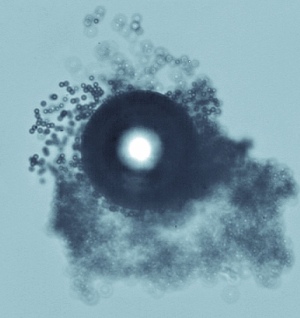Scientists have demonstrated that they can make tiny bubbles shed a coating of particles they are wrapped in, using sound.
The video above shows how the team use ultrasonic sound waves to eject particles from a bubble’s surface. The video has been slowed down 100,000 times so that the process can be viewed by the naked eye.

Bubbles carrying drug particles could deliver more targeted drug therapies
Researchers are currently exploring how to deliver drugs by coating microscopic bubbles with nanoscopic drug particles. As these bubbles are tiny they could be injected safely into the bloodstream, and the drugs released only in areas of the body where they are needed. The advantage of this is that treatments such as chemotherapy can more directly target cancers, which would reduce adverse side effects in the body. Scientists are interested in using bubbles in healthcare applications because they oscillate or vibrate when they are subjected to sound at high frequencies, which is useful because it can act as a trigger for ejecting drugs. However, the current challenge has been finding a way of triggering this vibrating mechanism to release drugs on command.
Now researchers from Imperial College London have demonstrated for the first time that sound at ultrasonic frequencies causes the bubbles to vibrate, which the researchers liken to a micro-scale earthquake, triggering the release of the particles clinging to their sticky, filmy surface. The bubbles then deflate, leaving no trace. They can also last for up to several months in a solution, when coated with the particles, which means that they could be stored without degrading.
More research will need to be carried out to measure the effectiveness of this technique for medical therapies. However, the team suggest that their work may be the first step towards a method for storing and delivering “drug micro-bubbles” in a targeted, quick and effective way to parts of the body.
The researchers say bubbles are already used in healthcare in ultrasound imaging, where patients with circulatory conditions have their blood flow monitored when harmless bubbles are injected in the body and high frequency sound bounces off them to track their movement. Combining imaging and drug delivery would make bubbles even more useful in therapies say the team.
The research was carried out by Dr Valeria Garbin and PhD student Vincent Poulichet, who are both from the Department of Chemical Engineering at Imperial.
Dr Garbin said: “We’ve taken the first steps to show that we can trigger the release of particles on command. We are working on making this technique a viable approach to drug delivery and our initial results are promising.
“Imagine a future where doctors may be able to inject harmless drug bubbles into your blood stream, monitoring their journey through your body and using high frequency sound to trigger the release of drugs when they float past a tumour, making treatments more rapid with potentially fewer side effects.”
In the study, the team mixed a solution containing particles and frothed it, which created and coated the micro-bubbles in particles. The team then subjected the bubbles to sound at ultrasonic frequencies, causing the filmy surface to vibrate, lasting for less than a thousandth of a second. This caused the particles to be expelled from the surface. The team imaged the process using a high speed camera, which filmed the micro-scale earthquake at a frame rate of 350,000 pictures per second, which is thousands of times faster than conventional video recording devices on phones.
The next steps will see the team testing how the bubbles deliver particles inside synthetic tissue that mimics human capillaries. They are also aiming to optimise and scale up the method in large volumes in an effort to move towards applications in industrial processes.
The research was published in the journal Proceedings of the National Academy of Sciences.
Article text (excluding photos or graphics) available under an Attribution-NonCommercial-ShareAlike Creative Commons license.
Photos and graphics subject to third party copyright used with permission or © Imperial College London.
Reporter
Colin Smith
Communications and Public Affairs

Contact details
Email: press.office@imperial.ac.uk
Show all stories by this author




Leave a comment
Your comment may be published, displaying your name as you provide it, unless you request otherwise. Your contact details will never be published.